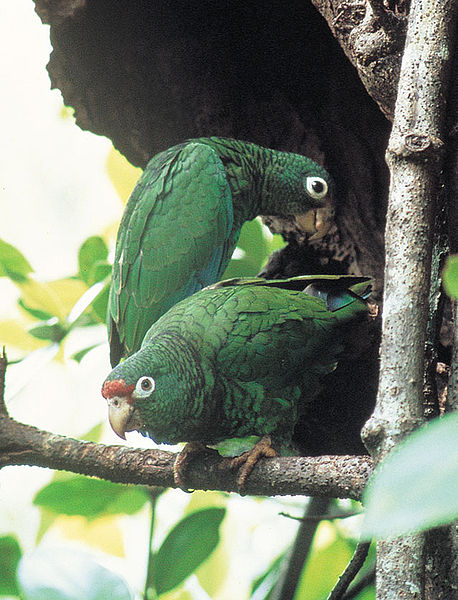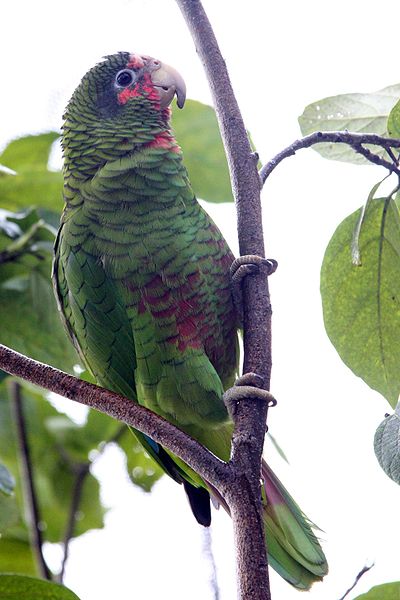 New efforts are underway to help 2 critically endangered Caribbean parrots, the Bahaman Amazon (Amazona leucocephala bahamensis) and the Puerto Rican Amazon (A. vittata). The various Caribbean islands are a hot-bed both of parrot diversity and parrot troubles – the Guadeloupe and Martinique Amazon Parrots, and a subspecies of the Puerto Rican Amazon (formerly found on Culebra Island), are already extinct.
New efforts are underway to help 2 critically endangered Caribbean parrots, the Bahaman Amazon (Amazona leucocephala bahamensis) and the Puerto Rican Amazon (A. vittata). The various Caribbean islands are a hot-bed both of parrot diversity and parrot troubles – the Guadeloupe and Martinique Amazon Parrots, and a subspecies of the Puerto Rican Amazon (formerly found on Culebra Island), are already extinct.
The Bahaman Amazon
The Bahaman Amazon, also known as the Bahama Parrot, is closely related to the Cuban Amazon (please see photo). It is limited in distribution to the Bahaman Islands of Grand Abaco and Grand Inagua.
The Problem with Ground Nesting
In addition to the usual pressures of habitat loss and over-collection, the population on Grand Abaco is at risk due to a unique nesting strategy. The island is composed largely of limestone, which (as is typical of limestone) is riddled with natural cavities and sinkholes. The parrots there nest on the ground, within these holes.
This was a useful strategy in the past, especially considering the absence of suitable arboreal nesting sites, and has allowed biologists to study the species in detail. However, raccoons and house cats have now been introduced to the island, and they too have easy access to the nests. It is believed that their predation on eggs and nestlings is currently the most serious threat faced by the Bahama Amazons on Grand Abaco.
A Conservation “First” for the Bahamas
Although precipitous declines in Bahaman Amazon numbers have been well-documented, a coordinated conservation effort on the birds’ behalf has been a long time in coming. A management plan, the first for any Bahaman animal, has finally been implemented.
The plan focuses on predator control, land use planning and the generation of public support (i.e. the Adopt-a-Nest Program, please see below). Importantly, it also summarizes all that is known about the parrot’s natural history, so that biologists can make informed decisions concerning the future of this specialized island dweller.
The Puerto Rican Amazon – World’s Rarest Parrot?
 Sadly, a few parrots vie for this title, but the Puerto Rican Amazon, also known as the Iguaca, is definitely one of the world’s 10 rarest birds. Despite decades of intense, well-funded conservation efforts, the entire population numbers less than 300 birds. That is, however, an improvement – only 13 individuals could be found in 1975.
Sadly, a few parrots vie for this title, but the Puerto Rican Amazon, also known as the Iguaca, is definitely one of the world’s 10 rarest birds. Despite decades of intense, well-funded conservation efforts, the entire population numbers less than 300 birds. That is, however, an improvement – only 13 individuals could be found in 1975.
Sugar cane farming, housing developments, poaching and introduced predators added to losses inflicted by hurricanes to push this island endemic to the brink of extinction. Ironically, this much-abused parrot may have had a role in leading Columbus to land in 1492 (please see article below)…I guess the parrots regret that move now!
Although the Puerto Rican Amazon’s situation continues to improve, conservationists believe that more can and should be done. Consequently, the US Fish and Wildlife Service, The Puerto Rican Department of Natural Resources, the Lincoln Park Zoo, Mississippi State University and other organizations have banded together to review and revise the recovery plan. Please see my article The Long Uphill Battle to Save the Puerto Rican Amazon Parrot for more information.
Further Reading
Informative Parrot’s International video featuring wild and captive Puerto Rican Parrots.
A researcher’s Bahama Parrot Blog.
Read about the Puerto Rican Parrot’s place in history: Did Parrots Help Columbus to find America?
Caribbean Endemic Bird Festival.
A. leucocephala in Grand Cayman image referenced from wikipedia and originally posted by Phillip and Snowmanradio
 That Bird Blog – Bird Care and History for Pet Birds
That Bird Blog – Bird Care and History for Pet Birds




Hello Frank, I enjoy your articles allot. I know you sent out one on Indian Ring Neck Parakeets one time. So can you please it to me again? Because I got one from a bird expo on Sunday. And love to lean more about them. Thank you for your time Frank. From, Linda
Hello Linda, Frank Indiviglio here.
Nice to hear from you again; Thanks for the kind words.
You can reach the article by clicking here. It is in 2 parts, and has links to related articles as well.
Good luck, enjoy your new bird and please keep me posted.
Best regards, Frank Indiviglio.